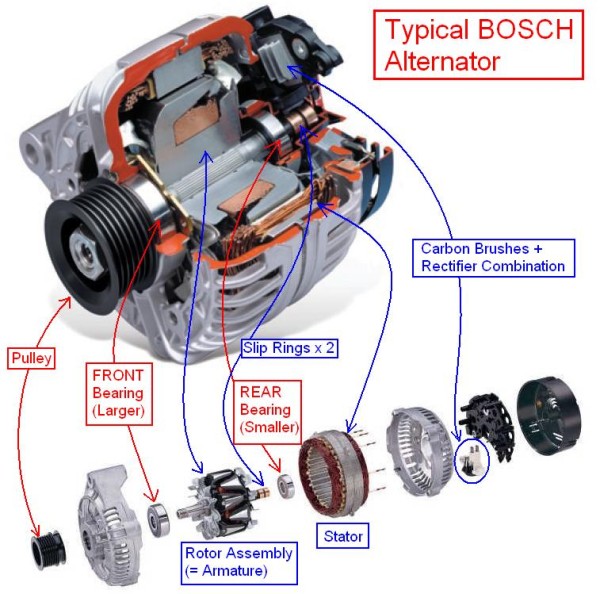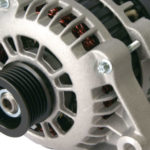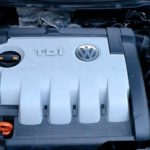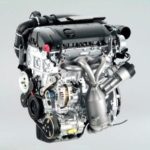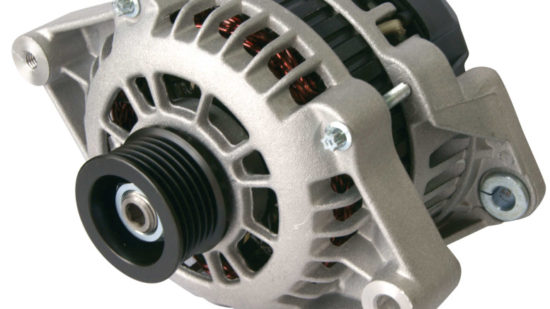What is an Alternator? What is the role of the alternator?
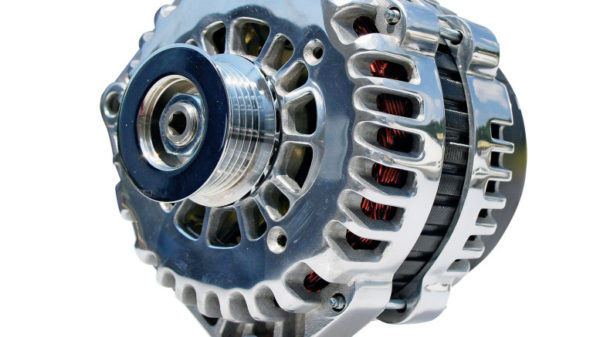
Alternator
The alternator is an electric generator that supplies electricity to all the car's electrical appliances and a full battery. A generator is a small power plant powered by an engine; when the engine is not running, electricity is supplied by the battery. An electric generator can be a dynamo - a direct current generator or an alternator - an alternator.
Today, most cars have AC generators, therefore an alternator; they are stronger and give even enough power to charge at the slightest turn of the battery. Since DC charging is required to charge the battery, all alternators also have an AC adapter that converts AC power to DC power.
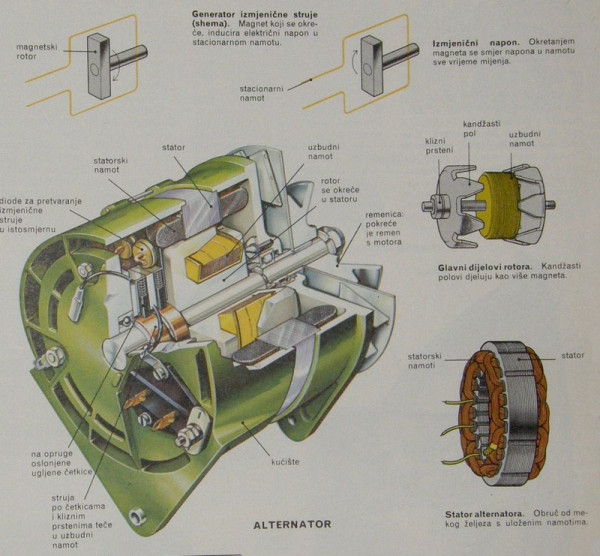
Alternator
All types of generators produce electricity by turning the rotor. In the alternator windings, in which current is generated, they rest and are wound on the stator surrounding the rotor. An alternating current generator (or alternator) has inductive windings, ie windings in which electricity is generated, on a stationary ring, the stator. In the middle of the stator, a rotor winding rotates, surrounded by claw poles. The rotor is an electromagnet with one excitation coil, which rotates, and whose ends are connected to separate sliding rings. The brushes on the slip rings supply electricity to the rotor winding. This creates a magnetic field with a north (N) and south (S) pole. If the magnetic field now moves (in this case rotates) next to the inductive winding, an electric voltage is created in the winding. The more magnets that pass by this winding at a certain time, the higher the voltage realized. If the rotor is split several times, the effect is the same, as if more magnets are rotating. Among other things, the advantage of the alternator is that there is no collector on which the removal of large currents in the dunes causes problems with sparking. The excitation current that the brushes bring to the rotor slip rings at the alternator is so small that sparking does not cause difficulties. In the alternator, the north and south poles of the rotor move alternately in relation to the stator windings, and an alternating voltage is created. Due to the battery, the car needs alternating current. Therefore, the current from the alternator should be converted to direct current by diodes or other rectifiers. The alternator found its way into passenger cars only after the discovery of silicon diodes and transistors, which replaced previously large rectifiers and voltage regulators. The alternator automatically adjusts its power transmission and only needs one voltage regulator.
The rectifiers also take on the role of return current switches. With the use of transistors, the regulators have become so small that they can be built into the alternator itself. The voltage of the electric generator must always be the same, which is why a control switch is connected to it, which limits the voltage and mitigates the transmission. If this were not the case, the battery would be overcharged or spoil the consumers. The regulator protects the generator from overload and the so-called return current switch prevents the battery from discharging through the generator, when it rotates slowly.
The alternator is not charging
The correct operation of the alternator can be monitored on the instrument panel where the control lamp is located. The control indicator is red and its illumination during engine operation is dangerous. Turning on the control indicator is a sign that something needs to be done urgently, otherwise the car will stop and damage the engine. It can be a harmless malfunction, due to poor contact, but also a complete cessation of operation of the alternator, when the battery can deliver electricity on its own for only a short time, depending on its capacity. Ignition of the lamp may cause the alternator drive belt to burst. In the case of a diesel engine whose water pump is driven via a second, V-belt or toothed belt, a longer ride is possible on such an occasion, if it is driven during the day and if the lights are switched off. However, if the water pump is started with the same belt, the vehicle should be stopped immediately, because, in addition to the alternator, the water pump will also stop working and the engine will soon overheat and water will be expelled from the system. As for the drive belt, it is of a different shape today than those on older engines. It used to be wedge-shaped, so in the absence of the same, we could replace it with a woman's sock, with which we connected the two pulleys well. Now it is a belt, multi-channel or PC belt and, except for the same ones, it cannot be replaced by anything, even for first aid. The PC belt is far more durable and reliable than its older brother, but it still has the common characteristic that on cold winter mornings it can squeak like a cat when it gets on its tail. The cause can be age, ie. fatigue or slight tightness. However, we must be careful when tightening, because too tight a belt will not squeak or squeak, but the bearings of the alternator, water pump, servo pump or air conditioning compressor will be much more loaded, so it will buzz faster. Mostly at this time, the construction solutions are such that the belts also have their own automatic tensioners, which are so tense that they tighten the belt well, and the bearings do not suffer.
In addition to belt bursting, the most common cause of the signal light is a faulty controller. This can mean brush wear and also the failure of the electronic part of the controller. Although brushes on some can be changed to save on repair, most often in both cases the regler is replaced. In such a failure, the intensity of the lamp in the operation of the engine is a pronounced red color, but if it burns "at half power", it will sooner be a fault in the diodes.
The malfunction is shown not by the appearance of the same red light on which the battery symbol is, but when the ignition is switched on. It may be that the fault is banal and the cause is just a blown control indicator, but again, a fault in the alternator is also possible. In both cases, the response must be fast, because the blown-out lamp will not be able to signal a possible future malfunction, and in the other case, the malfunction only has not occurred. You can even sniff out a broken regler. When the cabin smells of strong acid, open the bonnet and check the upper surface of the battery. If it is wet, it means that acid is ejected from the battery due to overcharging. As we said before, the one who is responsible for the properly stuffed is the regler, so it needs to be changed urgently. If you decide to do it yourself, be sure to disconnect the battery cables so that the metal wrench does not accidentally touch a "plus" and thus damage what was correct up to then.
Retrieved from: auto-mane.com
Recommendation of similar texts:

Hi there, I am Mladen and I am an auto enthusiast. I started this blog years ago to help like minded people share information about latest cars, car servicing ideas, used car info, exotic cars, and auto technology. You will find helpful articles and videos on a wide variety of cars - Audi, Mercedes, Toyota, Porsche, Volvo, BMW and much more. Ping us if you have anything cool to share on latest cars or on how to make older cars more efficient, or just want to say hi!

